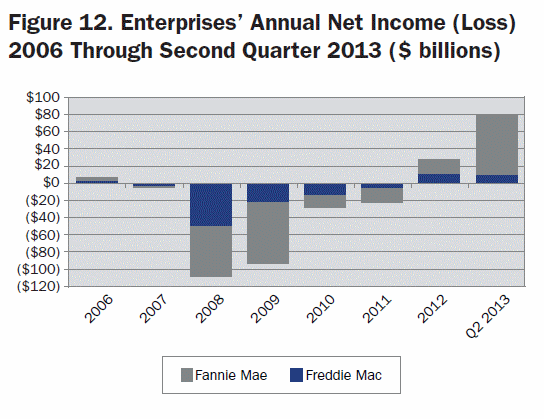The Office of Inspector General (OIG) of the Federal Housing Finance Agency (FHFA) has released its sixth Semiannual Report to the Congress. The report covers OIG's activities from April 1 to September 20, 2013. OIG summarized its audits which numbered 16 during the six month period, evaluations and other reports relating to the nation's housing finance system. These included an evaluation the security of of Freddie Mac and Fannie Mae's (the GSE's) technology systems, an assessment of the Home Affordable Refinance Program, and FHFA's efforts to gradually increase the GSEs' guarantee fees. OIG also reported on investigations which resulted in the indictment of 75 individuals during the period, conviction of 55, and the recovery of more than $104 million in criminal fines and restitution orders.
OIG also provided an overview of FHFA and its relationship with the GSEs; a brief discussion of the GSE's business models, and a section titled "Lessons for Housing Finance Reform: Five Years after the Federal Government's Takeover of Fannie Mae and Freddie Mac." This section includes a discussion of three factors that are important to a safe, stable, and liquid mortgage market, regardless of the form that market takes. OIG said it was drawing on its experience to speak about soundness, oversight, and balance and was not seeking to take sides in the current discussions about GSE reform or that of the larger finance market.
OIG devotes a section of the report to the GSEs' recent financial performance. During the period ended June 30, 2013 both GSEs reported record profits which have been rising since 2012 and are beginning to offset the losses that started in 2007. The second quarter 2013 results for Fannie Mae were $68.8 billion and for Freddie Mac $9.5 billion.

OIG said there were several reasons for the recent financial successes:
- In the case of Fannie Mae, a key factor is the release of a substantial portion of its valuation allowance against its deferred tax assets. The GSEs are required to maintain a valuation allowance for deferred tax assets they feel might not be realized. This caused them to establish substantial allowances during the years they experienced net losses. In the first quarter Fannie Mae released a substantial portion of its valuation which resulted in the recognition of $50.6 billion as a federal income tax benefit.
- There were continued improvements in the value of the GSEs' single family business segment. These were driven by stronger credit quality of the loans, increases in the guarantee fee income because of FHFA directed fee hikes; an increase in home prices causing a reduction in defaults, and derivative gains due to an increase in swap rates.
- The GSEs also benefitted from extraordinary government measures to support the housing market in general. These include the $1.3 trillion in GSE mortgage-backed securities (MBS) purchased by the Federal Reserve and $135 billion in GSE issued bonds.
The GSEs of course have received an aggregate of $187.5 billion in support by the U.S. Treasury which allowed them the time to make the improvements and put their activities on a sound footing. Against these Treasury draws the GSEs have paid $146.2 billion in dividends, none of which has reduced the monies owed to the Treasury.
OIG says that the GSEs currently do not require further government support. Treasury's last purchase of GSE MBS through the GSE MBS Purchase Facility was in December 2009, and the Federal Reserve last purchased MBS and bonds from them in March 2010.







